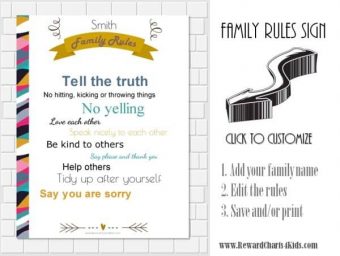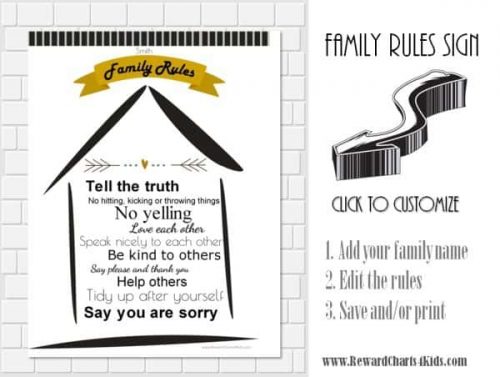House Rules for Kids

When children do behave as expected it is important to reward good behavior so as to reinforce it and encourage children to continue behaving in this manner.
As a parent, it is your responsibility to ensure that your kids know exactly what is expected of them. Establishing a set of house rules can help you achieve this goal.
Most families have house rules but they are not always clearly defined. Writing down your set of house rules ensures that the rules are clear and that everyone is on board.
How do you establish House Rules for Kids?
1) Define problematic behavior
Think about your child’s behavior or children’s behavior if you have more than one child. Jot down the issues that need to be addressed.
2) Define the most challenging periods during the day
Is there a time of day that you find particularly challenging? Doing homework? Getting ready for school or daycare? The melting hour? Time to go to bed? Time to get into the shower?
3) Make a list of chores that need to be done
Cleaning up, picking up toys or any other chores that need to be done around the house. The chore list obviously changes according to the child’s age and ability.
4) Prioritize issues that need to be addressed
You cannot have a list of house rules which is a mile long. Make a realistic list of rules that everyone can stick to.
According to CDC, when you first start using family rules, you may need to choose which problem behaviors to address first. Toddlers and preschoolers can only learn and remember two to three rules at any one time. It is also hard for parents to consistently enforce lots of new rules. They suggest starting with just one rule and adding new rules as needed over time.
5) Make the rule short, clear and easy to understand
According to CDC, you should avoid vague rules, such as “be good.” A more specific rule would be “Talk nicely to others.” The rules should also be realistic and fit your child’s age.
6) Have a family meeting to discuss the concept
Tell the children that you would like to have a calmer and happier environment at home and you would like to share ideas on how to achieve this goal. Ask them for suggestions and proposed rules that they think they should follow. They might have creative ideas that you haven’t considered. The more involved they are in this process the more likely they are to follow the rules. If a child suggests a rule which is later included in the list they will be more likely to follow it than a rule that you have decided upon without hearing their opinion.
Take notes during the meeting but make it clear that although you want to consider their ideas and rules the final set of rules will be decided upon by their parents. Although all family members will live according to these rules (parents too!) you – as a parent – have the right to decide exactly which rules will or won’t be included in the house rules. Having ice cream for breakfast might be an interesting suggestion but obviously will not make it to the list of house rules.
7) Have all regular caregivers agree on the house rules
Once you have completed each of the previous steps parents can then decide upon the final set of rules. It is important that parents agree on each and every rule on the list. If parents do not agree on the house rules then they will not work. It is important that both parents are united and consistent throughout the process.
8) Present the rules to all family members
Have a family meeting and present the rules. Ensure that each of the rules is clear and understood. Use pictures for kids who cannot read. Make a copy for each family member and/or put a copy somewhere prominent, such as on the fridge, so that you can see them every day. If you have a regular babysitter or caregiver make sure that they are aware of the house rules.
9) Praise children when rules are followed
Reward charts can help with this. Find a reward system that works with your children. You can find many ideas on this site. If you witness a conflict between your children during which they talk to each other respectfully and explain to each other why they each think that their sibling is wrong without fighting about it stop to praise them for the manner in which they chose to deal with the conflict. Siblings will not always agree with each other but that is legitimate. It is important that each child has their own opinion and we do not want them to necessarily automatically agree with their sibling’s opinion. They should have their own opinion and stand up for their rights but it is important that they do so in a relaxed and respectful manner without yelling or violence.
10) Decide on the consequences when rules are broken
Discuss exactly what the consequences are and don’t forget to enforce them. Consequences for breaking family rules should be clear to both the parent and child. According to CDC, consequences for broken family rules should be enforced immediately. They can be included on the rules chart as a reminder of what to expect.
11) Be consistent
If you allow children to break the rules the system will not work. It will not be clear when the rules can be broken and when they can’t. Occasionally you will need to break the rules. When you do break a rule, explain to the child why the rule was broken so they understand that this is not a sign that the rule does not apply but that special circumstances require a deviation. For example, if your house rule is that children need to be in bed by a certain time and then the family attends a special event that will cause them to arrive home after their bedtime.
Explain to them that in order to attend the event you have decided to extend their bedtime that day. This will make it clear that their bedtime has not changed and the next day you will be following the rules again. They will also understand that although that particular rule will be broken that day all other rules still apply. So although they will be going to bed late there will still be no fighting that day. Also, they will understand that the rule regarding their bedtime will be inforced the next day.
12) Set an example
If you do not follow the rules that apply to you then you cannot expect your children to follow their rules. So if you decide that there will be no yelling in the house then both you and your partner have to follow this rule too.
Family Rule Sign Printables


